The Apple Thunderbolt Display Review
by Anand Lal Shimpi on September 23, 2011 2:56 AM EST- Posted in
- Displays
- Mac
- Apple
- Thunderbolt
- Thunderbolt Display
Ever since I moved to a notebook as my main work computer I've become increasingly annoyed with the process of actually moving my notebook-as-a-desktop around. At my desk I've got DisplayPort, Ethernet, two USB, FireWire 800, speakers and power all plugged into a 15-inch MacBook Pro. What makes it frustrating isn't the first-world-problem of having to unplug seven cables, rather that it doesn't need to be seven cables - Apple could make the whole thing happen with just two.
Every Mac released in 2011 has at least one Thunderbolt port (the iMac has two), and Thunderbolt can deliver exactly what I'm looking for. Thunderbolt can carry two things: PCI Express and DisplayPort, the former for data and the latter obviously for video. Why would you want to carry PCIe and DP over a single cable? To address problems like the one above.
Pretty much all device expansion on modern day PCs happens via PCI Express. Several years ago it was hard to find PCIe sound cards or Ethernet controllers, but these days vanilla PCI slots are nearing extinction and PCIe is the de facto standard. Ethernet, USB and FireWire controllers all exist as single-lane PCIe devices. Put a bunch of them at the other end of a Thunderbolt cable and you no longer need to plug in a bunch of individual cables into your notebook when at your desk. Send DisplayPort over the same cable and you can actually move all of those ports onto your monitor, thereby using a single cable to carry everything but power to your display. And this is exactly what Apple has done with its new Thunderbolt Display. By mating its 27-inch LED Cinema Display with a bunch of integrated IO controllers, Apple is hoping to deliver a display that's more of a mobile docking station than just a passive way to display video.
Apple has tried this in the past. The old Cinema Displays used to feature an Apple Display Connector (ADC) that actually carried DVI, USB and power from a desktop Mac to the monitor. You only needed to plug in a single cable to your display, significantly reducing desktop clutter. Although Thunderbolt does carry power, it's limited to 10W - not enough to power any reasonably sized display. Where Thunderbolt does win out over ADC however is in its universal appeal. Intel created the standard. Although it's used almost exclusively on Apple systems today, come 2012 Intel is expecting PC OEMs to embrace the interface with its Cactus Ridge line of Thunderbolt controllers.

Apple's Thunderbolt Display
The Thunderbolt Display uses a near, if not perfectly, identical panel to what was in last year's 27-inch LED Cinema Display. You get a 27-inch, 16:9, 2560 x 1440 LED backlit display capable of at least 350 nits at full brightness. Apple seems to conservatively spec its desktop displays as we were able to measure 425 nits at max brightness. The uber brightness comes in handy because the display does have a glossy finish. Indoors it's not really a problem unless you're watching a dark movie scene with the display lit by a sun-facing window. Even then, cranking up the brightness all the way is usually enough to overcome any significant glare. As with all glossy displays, if you have light control (e.g. curtains or blinds) you'll be just fine.
The similarities don't end with the internal panel, the chassis is very similar to its older sibling and the Thunderbolt Display retails for the same $999 price.
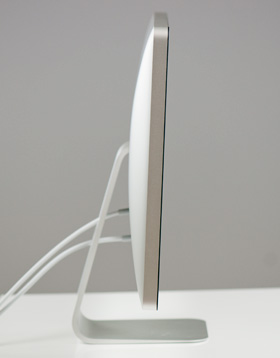 |
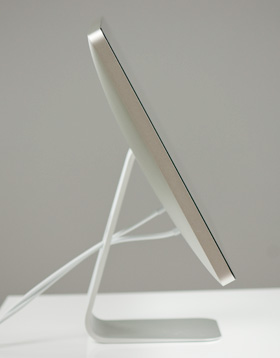 |
The display sits on an aluminum swivel base that allows for -5 degrees to 25 degrees of tilt along the horizontal axis. There's no height adjustment for the display either, only tilt. Personally, I use a height adjustable desk as I find it helps me avoid any carpal tunnel pain. Combined with a height adjustable chair, the lack of height adjustment on the display doesn't bother me. If you have a fixed height desk however, this may be a problem.
Aesthetically the Thunderbolt Display continues Apple's aluminum meets glass design language. The front of the display is all glass, while the edges and back are all aluminum. Along the top surface of the display is a mic for the integrated FaceTime HD camera. The outgoing 27-inch LED Cinema Display (still available for purchase online) sported a 640 x 480 camera, while the Thunderbolt Display ups capture resolution to 1280 x 720.
There's an ambient light sensor hidden in the top bezel of the display, but as always you can disable its functionality from within OS X.

There are two integrated speakers in the display, again unchanged from the previous LED Cinema Display.
Two cables attach directly to the display: a removable power cable and an integrated IO cable. Cable management is done through a round cutout in the aluminum stand. The IO cable is where things really change with the Thunderbolt Display. Instead of a breakout of three cables as was the case with the Cinema Display, there are now only two: MagSafe and Thunderbolt.
The MagSafe connector remains unchanged. If you've got any Mac that can be charged by an 85W MagSafe adapter, the Thunderbolt Display will charge said Mac. This feature alone is particularly awesome for notebook-as-a-desktop users since it allows you to just keep your actual AC adapter tucked away in your travel bag. For me I keep my MagSafe adapter in my bag and never take it out so I never have to worry about forgetting to pack it. Given how expensive MagSafe adapters are ($79 for an 85W), this is a nice feature for MacBook Air/Pro owners.
The Thunderbolt cable is obviously what gives this new display its name. Inside the Thunderbolt Display is an Intel Light Ridge Thunderbolt controller. The type of controller is important as it bestows upon the display some clear limitations. The biggest of course is the lack of support for all non-Thunderbolt systems. That's right, the only way to get video to the Thunderbolt Display is by using a Thunderbolt enabled Mac (or theoretically a Thunderbolt enabled PC). For Mac users that means only 2011 MacBook Pro, Air, iMac or Mac mini models will work with the Thunderbolt Display. Everyone else has to either buy a new Mac or stick with older displays.
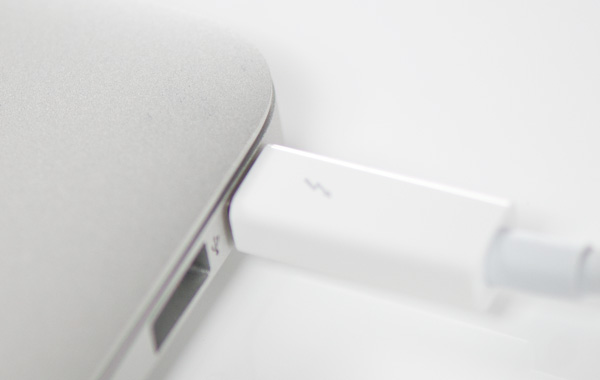
I believe the limitation here is actually on the cable side. A Thunderbolt cable can only transmit a Thunderbolt signal. Although DisplayPort is muxed in, if the display on the other end is expecting Thunderbolt and it receives DisplayPort it won't know what to do with it. It's possible Apple could have built in logic to autosense and switch between Thunderbolt and DisplayPort as inputs, but Apple traditionally employs clean breaks rather than long technology transitions. If Apple wants to ensure Thunderbolt gets adopted (at least by its users), this is the way to do it. As we learned from other legacy interfaces (e.g. PS/2, IDE), if you enable backwards compatibility you'll ensure the survival of systems that implement those interfaces. It's not so great for existing customers unfortunately.


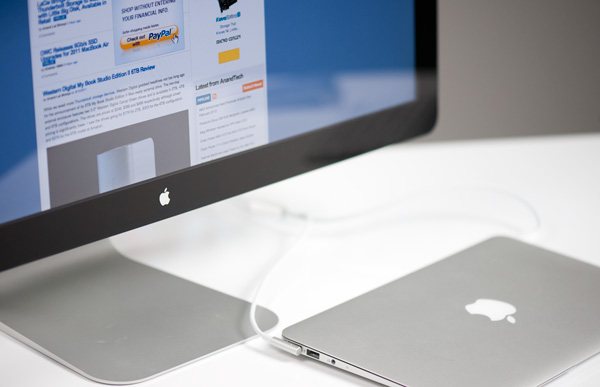
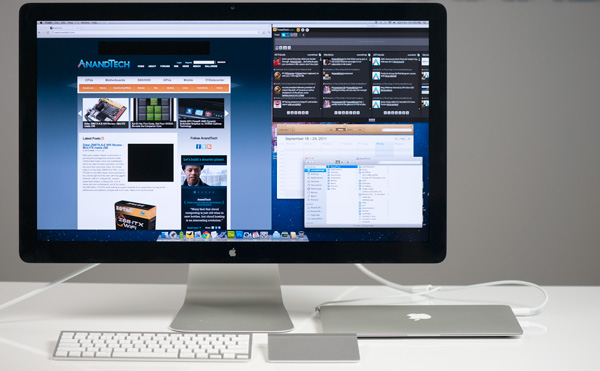
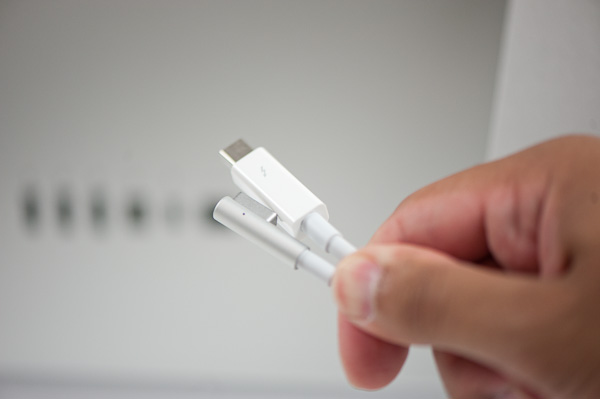








275 Comments
View All Comments
repoman27 - Tuesday, September 27, 2011 - link
I'm just going off the information available, like everyone else. Which is why probably half the statements I've made about TB thus far have turned out to be inaccurate.But the TB port is electrically equivalent to a mini DP port. There are no additional contacts. A TB port operates in either DP compatibility mode or in TB signaling mode. The 4 pairs of signaling wires are used for either 1 DP main link Tx or 2 TB bi-directional channels, both of which are capable of transporting (tunneling) a DP main link. As far as I can tell at least.
I posted a block diagram earlier, which I'll post again here, although I need to clean it up a little as my current theory of things Thunderbolt is now a bit more plausible. http://i54.tinypic.com/8zdwci.jpg
repoman27 - Monday, September 26, 2011 - link
I just noticed that my math was a little too quick and dirty. There's only one FireWire 800 port on the ATD, not two. So actually a second USB 2.0 controller or memory card reader were not out of the question at all, and probably just failed to make the cut due to cost.An optical drive would have required a SATA controller, which wouldn't have fit within the bandwidth limitations, and altogether would have added about another $50 to the price tag.
repoman27 - Sunday, September 25, 2011 - link
I find it bizarre the number of tinfoil hat conspiracy theorists that post comments on every review of an Apple product saying that the review was biased or nothing but a paid advertisement. I’m not sure how you could read this article and not believe that it was anything other than the most objective, informative and detailed review of the ATD yet published.Some points for consideration:
There are plenty of reviews on Anandtech for products made by manufacturers that also advertise on Anandtech, yet these are never called into question. It’s just Apple, who to my knowledge have never actually advertised on a review site.
While Apple does submit products for review, Anand went out and additionally bought his own ATD to dissect, so he actually paid Apple this time around. I doubt his review unit came packed in a box full of cash.
There are no generally negative reviews posted on sites like these because the authors tend to spend their time reviewing products that have merit. Most of the major manufacturers don’t make a habit of bringing to market products that are clearly defective or devoid of any useful functionality. Apple makes solid products, and therefore gets a lot of positive reviews. Not that they are by any means above critique, but their standards tend to be higher than many of their competitors.
Being objective is not the same as being impartial. The biases of reviewers will always show up in what they write, but stating opinions does not necessarily diminish the objectivity of the data presented.
People who can’t figure out the timing of the posts on this site are baffling to me. When AMD, Intel or NVIDIA release new products, we get a quick blurb when it is announced and a full review a few days after it ships. When MWC is going on you get a ton of mobile device news, when IDF is going on you see a mess of Intel related posts, when BUILD is happening you’ll have a bunch of Microsoft stuff to check out. Yet so many people submit comments saying that this site has jumped the rails when WWDC results in a week of Apple posts.
Why did the ATD get an in depth review? Because it marks the release of a highly anticipated piece of tech which was surrounded by many unknowns due to the fact that it actually forges into some new territory. Is there really a good reason why this site would NOT review this device? The only reason I can think of would be if a competitor had paid them off.
If all those bitching about the quality or integrity of this site can point to better, more objective, more in depth reviews of these products, please feel free to cite references.
Brigga - Sunday, September 25, 2011 - link
As simple and probably silly as this sounds why doesn't apple have a docking station? Port replicators suck, but docking stations can be quite unobtrusive and easy to use (ie. no disconnecting of cables and second power supply stays where it is).repoman27 - Monday, September 26, 2011 - link
Yeah, actually Apple solved the problem that way for five years back in the early nineties. The PowerBook Duo line had a docking port that worked with the Duo Dock and several other docking accessories. I'm guessing that they have enough bad memories of the problems inherent with those designs that they're shooting for a slightly different approach now.pesos - Sunday, September 25, 2011 - link
I went out and picked up a TB display last night to pair with my 2011 mbp. I live in windows about 95% of the time and expected there to be no issues with the basic usb hub built into the display – unfortunately that does not seem to be the case. My Apple usb keyboard (also brand new) and dell usb mouse both hang/freeze/work erratically when connected to the back of the display, as does my Jabra pro headset. I can make the behavior 10 times worse simply by using hardware built into the display, such as the facetime camera. If I fire up Lync and start a video chat, my keyboard and mouse become nearly unusable. My basic testing under Lion appears to confirm this is an issue with Apple’s boot camp drivers as things work fine under OS X. Problem occurs both with win7 and win2008r2.shin0bi272 - Sunday, September 25, 2011 - link
first world problems...Oli56 - Sunday, September 25, 2011 - link
Anand, great review but it seems you completely overlooked the impact of the glass which can be negative to some users. I owned an iMac some time ago and the glass reflections were very disturbing to me and led to ocular fatigue. It is unfortunate Apple has moved to glass display for all its line of screens, fortunately we can still have a MacBook Pro with mate display as option but that doesn't exist for a 27" IPS screen which should really benefit from it. So basically glass maybe looks cool on display but when this is about to work all day with it, this is a nightmare. This is the only thing keeping me away from that screen, as the rest of it looks great.dmaffei - Monday, September 26, 2011 - link
You never fail to impress... nice job old friend!!!Dan :-)
StefanoT - Monday, September 26, 2011 - link
so this really, really, is an Apple Display without DisplayPort?!If I'm not mistaken, just the other day DisplayPort was the way to the future, touted to eventually supersede DVI/HDMI. Indeed, it was almost too new to be widely supported! DisplayPort-enabled monitors, in my part of the world, are still few and far between. I was still waiting for the DisplayPort goodness to free me from carrying all sorts of miniDP adapters. To DVI, to HDMI, even (gosh!) to VGA!
And now, suddenly, DisplayPort is to fall into oblivion, no longer supported by Apple, which was one of the main proponents and, ironically, now supports a standard that is built-on and, in a way, includes DisplayPort, and on top of that shares the same connector.
Anand points out that the company has never got emotional about legacy stuff. If they did, the new technology would never get adopted. Apple is leaping to the future and can't get stop to deal with yesterday's interfaces. I would say that between one leap and another, you need to "land" somewhere. I'm not a fan of never-ending legacy support, but I'm still waiting for VGA to disappear from mainstream netbooks. Are they suggesting that I either ditch my oh-so-non-2011 devices (i.e., "not-released-in-2011", as opposed to "not-bought-in-2011") in order to use their new display, or that I buy an old, "non-Thunderbolt" version of their display, which sells for the same price? This doesn't make sense any way you put it... and to think that they had it so easy with Thunderbolt. The thing seems built with backward compatibility in mind.
I didn't get if future displays will eventually support both DisplayPort and Thunderbolt. Perhaps once Intel makes it piece-of-cake easy, as opposed to "just add a chip to that big motherboard you've got back there, behind the glass". Perhaps once other companies start offering it. Or perhaps never, because why should Apple not leapfrog everybody again (including its customers), by switching to an all-new technology next year?